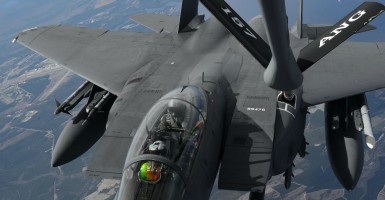On August 8, 2014, the U.S. began an air campaign against the Islamic State, also known as ISIS.
One year later, we have little to show for our efforts.
ISIS is the first terror group to form a financially independent regime, as well as the first to provide civil services to civilians in its territory.
President Obama’s strategy to defeat ISIS remains ambiguous at best, and nonexistent at worst.
Supposedly, America will defeat the terror group by “harnessing all elements of American power across our government—military, intelligence, diplomatic, economic development, and perhaps most importantly the power of our values.”
Besides being incredibly ambiguous, Obama’s strategy is failing on nearly all fronts.
The terrorist organization’s ability to recruit has grown (especially in the U.S.), they are maintaining a steady income from illegal oil exports, and the U.S.’s $500-million plan to train Syrian fighters has produced a total of 60 trainees.
So far, the only effective facet of the strategy has been the Air Force’s bombardment of enemy positions, but this alone isn’t enough. While air strikes have killed thousands of militants, these strikes alone aren’t able to counter ISIS’s massive inflow of recruits.
As of July 15, the Air Force had destroyed 7,655 targets, inflicting an unknown number of enemy casualties. It accomplished this with only $3.21 billion in funding—significantly less than the average $4.6 billion it cost to deploy a brigade combat team for a year during the height of Operation Iraqi Freedom.
Considering that 68 percent of Americans view ISIS as a “very serious threat,” almost double the number who view Iran as the same, the administration should revise its portrayal of ISIS as a “junior varsity” threat. As it has been said, “if we want to win, we have to stop underestimating our enemy.”
Both sides of the aisle agree that if we eventually put American boots on the ground, we shouldn’t make the decision to do so lightly.
The best way to prevent the conflict from reaching that point is to deal with the problem now.
The Heritage Foundation has previously assessed that the best way to address the threat ISIS poses is by ramping up air strikes, embedding more Special Operations Forces with Iraqi and Kurdish troops and using special forces in direct-action missions when needed.
ISIS maintains a strong grip over its territory. Local tribes aren’t likely to oppose ISIS outside their own territory, and nearby states don’t have the capacity to secure another state in addition to their own.
With so many regional disturbances, it is hard to fault them.
This means that an external force may eventually be required to lead the charge and subsequently prevent new extremist groups from filling the gap.
Whatever this external force comprises, the fact remains that we need a better strategy that will prevent ISIS from becoming the center of future Islamic extremism.
Leaving the region in turmoil will only lead to greater and more costly problems down the line.
This, or any other course of action, however, will require more defense funding—and a good place for Obama to start would be by signing the Fiscal Year 2016 National Defense Authorization Act into law instead of holding it hostage for political gain.
But until then, Obama can at least be satisfied knowing Iraqis are covered under Jihadicare.




























